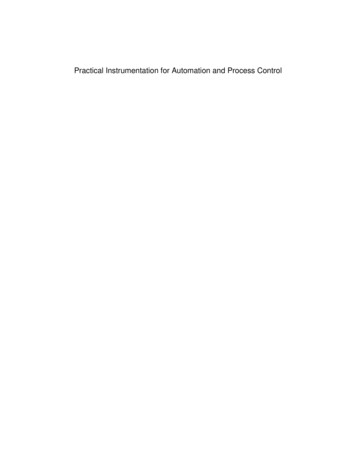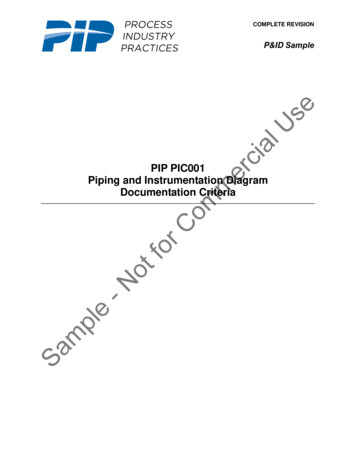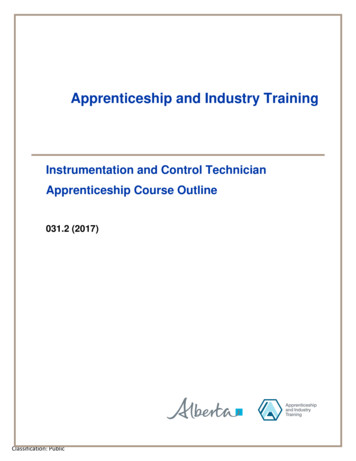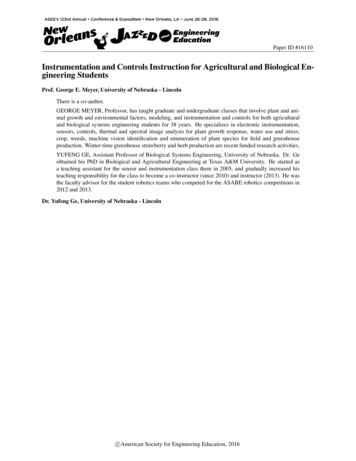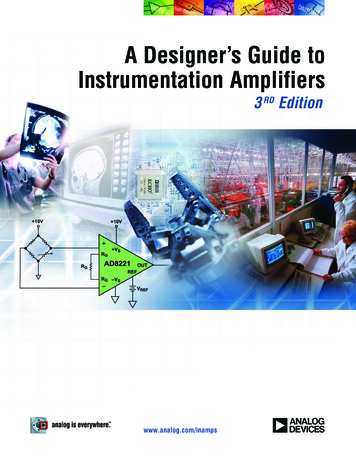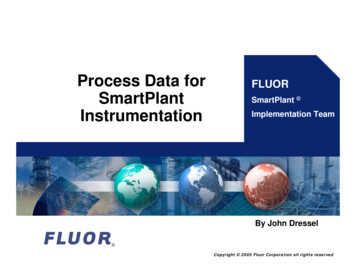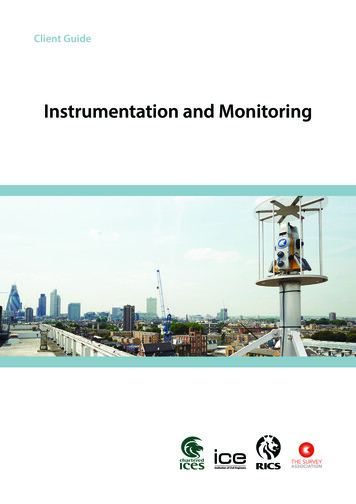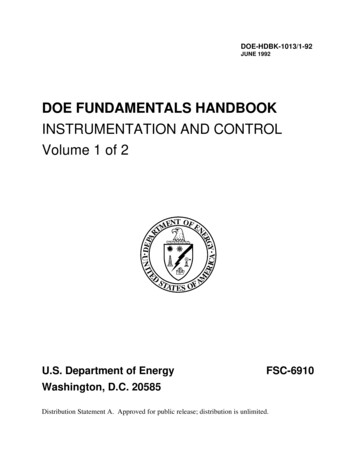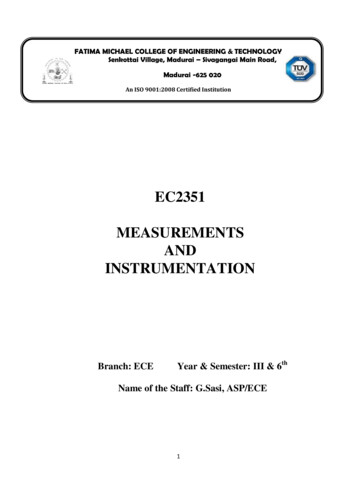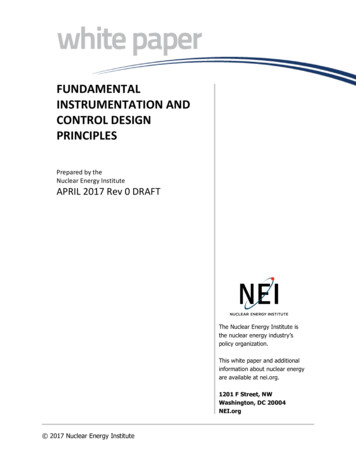
Transcription
FUNDAMENTALINSTRUMENTATION ANDCONTROL DESIGNPRINCIPLESPrepared by theNuclear Energy InstituteAPRIL 2017 Rev 0 DRAFTThe Nuclear Energy Institute isthe nuclear energy industry’spolicy organization.This white paper and additionalinformation about nuclear energyare available at nei.org.1201 F Street, NWWashington, DC 20004NEI.org 2017 Nuclear Energy Institute
PurposeThe purpose of this position paper is to re-affirm the four fundamentalInstrumentation and Control (I&C) design principles of redundancy, independence,deterministic behavior, and defense-in-depth and diversity (also referred to as the“four pillars”) and one attribute of an appropriate level of simplicity, as a solid andeffective foundation for demonstrating nuclear safety and reliability. Adequatedocumentation of conformance to the aforementioned principles provide sufficientbasis to support the licensing process and specifically the license amendment review(LAR) process, inclusive of digital systems and equipment. The licensing reviewprocess for digital I&C systems and equipment is defined currently in U.S. NRCDigital Instrumentation and Control Interim Staff Guidance #6 (DI&C-ISG ISG-06),Revision 1, Task Working Group #6: Licensing Process (ADAMS Accession No.ML110140103).This discussion is also intended to provide perspectives on steps that could be takento support fulfillment of the objectives of SECY-16-0070, Integrated Strategy toModernize the Nuclear Regulatory Commission’s Digital Instrumentation and ControlsRegulatory Infrastructure. This paper is focused on Modernization Plan (MP) #4which focuses on identifying and implementing a complete set of activities needed toprovide near-term regulatory clarity and support industry confidence in performingdigital I&C upgrades, while being mindful of the licensing basis differences of thenuclear fleet.This paper is not intended to solve all of the issues identified, but rather to provide aline of sight to issue resolution. This paper provides a vehicle to facilitateconstructive discussions and gain NRC staff/industry concurrence on a path forward.IntroductionThere is an urgent need to establish a clear, unambiguous regulatory “roadmap” fordigital I&C to achieve certainty, consistency, and reasonable focus in the licensingreview on attributes that are relevant to nuclear safety and reliability. With a focuson I&C, the overarching goal is to sustain nuclear safety consciousness coupled witha high regard for efficiency and effectiveness in relevant processes, thereby reducingunnecessary regulatory burden. This approach should not compromise public healthand safety, security, and environmental stewardship.The fundamental I&C four design principles of redundancy, independence,deterministic behavior, and defense-in-depth and diversity provide definitive andrelevant criteria that can be applied consistently to make a safety determination andsupport licensing reviews of proposed changes to the existing operating plants aswell as design reviews of new plants. This approach is performance-based as itsupports the foundation of the plant safety analyses, technology neutral, andsupportive of initiatives to modernize the regulatory infrastructure. Additionally, thisapproach supports initiatives to provide durable guidance. Furthermore, the I&C 2017 Nuclear Energy Institute2
design principles have meaningful correspondence to 10 CFR 50 Appendix A,General Design Criteria for Nuclear Power Plants (GDC), and are directly relevant tosafety significant I&C systems and equipment (the attached figure provides a highlevel graphical representation of this association).(ANSI/)IEEE Std. 279-1971, Criteria for Protection Systems for Nuclear Power Generating StationsIEEE Std. 603-1991 (with 1995 Correction), Criteria for Safety Systems for Nuclear Power Generating StationsAs identified in DI&C-ISG-06 Rev. 1: “the purpose of the NRC review is to assesswhether the facility and equipment, the proposed use of the equipment, theprocesses to be performed, and other technical criteria will comply with theregulations (e.g., 10 CFR 50) and that public health and safety will be protected. Itis not intended that the review or audit activities by the reviewer include anevaluation of all aspects of the design and implementation of the I&C system. Thereview scope is of sufficient detail to allow the reviewer to conclude the LARcomplies with the regulations.” DI&C-ISG-06 Rev. 1 notes that while process isimportant, software lifecycle processes are not a substitute for a detailed review of 2017 Nuclear Energy Institute3
the hardware and software architectures to conclude that the system, hardware,software architecture and human-systems interface meet the four fundamentaldesign principles and provide an appropriate level of simplicity.These four fundamental design principles are also applied in the review standard forsmall modular reactors (SMRs) as discussed in the mPower and NuScale DesignSpecific Review Standard (DSRS). The additional cross-cutting attribute of Simplicityis described in the DSRS (Section 7.0, Appendix C, Instrumentation and Controls –Simplicity) as well as in DI&C-ISG-06.In order to determine the relevant Instrumentation and Controls review guidance, itis essential to establish a common frame of reference on the specific safety criteriaassociated with nuclear power plant design. Once the safety criteria are affirmed,the requirements associated with the criteria can be elicited to establish a consistentand meaningful framework. This is not intended to assert that the existingregulatory framework is not meaningful, but there are aspects of the framework thatcould be considered extraneous, loosely defined, difficult to apply to changingtechnology, or subjective. These aspects create uncertainty and variability in thereview process.DI&C-ISG-06 Rev. 1 entails the submittal of a significant number of softwarelifecycle documents. However, there is no documented acceptance evaluationcriteria (other than BTP 7-14) that has been provided or applied to thedocumentation associated with safety-related software. Additionally, it is not clearthat this documentation provides or demonstrates any discernible correspondence tosoftware quality (vs. process adherence) and more specifically to integration of thesafety significant attributes such as correctness, fault avoidance, fault tolerance,fault detection, fault removal, integrity, dependability, fail-safe operation, or gracefuldegradation.The following attributes can be shown to relate directly to, or support assurance of,nuclear safety and reliability: A description of the system and the ability to perform the design basisfunction, including how the system architecture, plant interfaces, and humansystem interfaces functionA description of the functional requirements associated with the systemA description of how the four pillars are used in the designA description of the simplicity, and a defense of the rationale behindcomplexities added to the system, to support key system attributes includingreliability, maintenance, calibration, test, operation, safety, reliability, etc.A description of the area of change or of the new system or equipment andbasis for the changeA description of the hardware and software aspects of the change andrelationship to the system 2017 Nuclear Energy Institute4
Demonstration of conformance to the regulatory requirements as embodiedin the fundamental I&C design principlesA description of relevant regulatory criteria beyond the fundamental fourdesign principles and one attribute, including demonstration of conformanceto the design principles and attributeA discussion with proof of reliability, deterministic behavior, and deterministictiming, including consideration of common cause failureA discussion of the requirements and methods for equipment qualificationtests and analysesA demonstration that hazards are accounted for adequately in relationship tosystem performance, interfacing systems and equipment, human-systeminterfaces, and overall plant and operator response relative to the responsecredited in the safety analysisA discussion of how the safety, reliability, and cyber security claims will bedemonstrated throughout the development life cycle and in operation in theplantThe documents submitted should support the evaluation of the impact on nuclearsafety and adherence to nuclear safety principles. Review of submittals should focuson the methods used to implement the nuclear safety philosophy and thus documenthow the system assures implementation of the principal safety functions andmaintains integrity of the principal safety barriers. These safety principles are tieddirectly to regulatory guidance and industry standards.The three principal (nuclear) safety functions are: Control of reactivity and avoiding reactivity excursionsAdequate cooling of the core and fuelConfinement of radiationThe three principal safety barriers that we maintain are: Fuel cladding integrityReactor coolant system boundary integrity, andContainment integrityA reasonable assurance case or safety claim can be made with the adoption of thefollowing principles that comprise the fundamental four design principles and oneattribute:a. Maintain independence from the resultant effects of a design basis event sothat the effects of the event or the hazards that precipitated the event do nothave a resultant adverse effect on performance of systems credited inmitigating the event. Maintain independence between the redundantchannels, divisions, and trains so that the any faults or failures in one 2017 Nuclear Energy Institute5
channel, division, or train do not affect the redundant channels, divisions, ortrains. This should incorporate CCF considerations and protection frominternal and external events, as well as design assurance of the requiredperformance capability]. The philosophy of independence extends to systeminteraction to ensure that the interactions do not result in unintended,adverse consequences.b. To assure acceptable safety margin, the fundamental design approach is toavoid reliance on, or crediting of, a single I&C system or single train ofequipment to perform a safety-related function.1. This principle is embodied in the single failure criteria (SFC). The SFCfundamentally implies the application of systems and equipmentredundancy. This redundancy can occur through the installation ofmultiple divisions of I&C systems and trains of equipment, and may beextended into redundancy within each division of I&C equipment.2. This principle is also embodied in the defense-in-depth anddiversity philosophy which deploys functionally diversity as a primarydefense, implementing multiple methods (barriers) to preclude failureof one method to protect the fundamental safety barriers. This mayinclude diverse systems and equipment as necessary to achieve highsafety margin and reliability, such as the Anticipated Transientswithout Scram (ATWS) mitigating system or multiple different systemsfor emergency core cooling.3. The defense-in-depth approach is further applied in the design forprotection against common cause failures in sensors, transmitters, andoutput devices.c. Minimize the probability of failure of systems and equipment when requiredto mitigate postulated design basis events. This philosophy drives adeterministic design which provides deterministic behavior anddeterministic timing. The deterministic design provides predictable andrepeatable performance of the safety functions.1. This is achieved by deploying highly reliable and dependableequipment and systems which are designed to exhibit deterministicbehavior and deterministic timing.2. As an extension of this deterministic design philosophy, systems andequipment are required to fail to a safe state or to a known, definedstate determined not to jeopardize safety. Thus, reactor trip systemsfail to the tripped state, but engineered safety features systems faileither as-is or non-actuated.3. Systems are required to be testable to provide assurance of continuedoperability and availability when required.4. System maintainability is a fundamental aspect of the design,extending down to software by ensuring documented, well-designed,understandable code. 2017 Nuclear Energy Institute6
d. An implicit approach to reliability is to deploy the design with minimalcomplexity, with the knowledge that complexity may be required to enhancereliability or reduce the potential for human error. Where complexity isrequired (e.g., self-diagnostics, redundancy within the equipment in a singledivision), the complexity is documented and justified as necessary andappropriate for enhancing reliability, surveillance, calibration, and otherrequired system or equipment attributes. Of course, there are tradeoffs incomplexity, such as increasing the complexity by designing the system toreduce the human actions necessary for surveillance which also decreasesthe potential for human error, which enhances system reliability.A fundamental precept is that the overall plant design applies good engineeringpractices for design, construction, operation, and maintenance, which relates toconformance to regulatory requirements, as well as industry codes and standardsand norms for achieving high dependability in performance.The licensees or applicants have the burden of proof (production of satisfactoryevidence) that the plant and the systems, structures and components (SSCs) aredesigned, implemented, constructed, installed, operated, and maintained safely withrespect to their application and maintenance of these guiding principles. Additionally,changes must be performed using the same guiding principles, using the same (orbetter) methods and processes to avoid compromising safety.To address this urgent need, the following six recommendations are proposed.These salient regulatory issues addressing digital design are discussed withreference to recommended resolution approaches. Since this paper is not intendedto solve the issues but only provides a line of sight to issue resolution and potentialpaths forward. This discussion therefore ties into the NRC IAP and the MPs identifiedto address industry issues. Normalize reviews using a discrete set of fundamental I&C design principles,which is the focus of this discussion. Establish a relevant set of designfeatures that could be applied consistently to achieve a safety and reliabilityclaim (e.g., application of EPRI 3002005326, Methods for Assuring Safety andDependability when Applying Digital Instrumentation and Control Systems) Improve the efficiency and effectiveness of the 10 CFR 50.90, Application foramendment of license, construction permit, or early site permit process fordigital upgrades by streamlining the guidance in DI&C ISG-06 and reviews tothe extent feasible by targeting the inputs that are relevant and germane todemonstrating adequate nuclear safety and for critically evaluating theattributes that distinguish the acceptability (i.e., safety and dependability) ofdigital designs. This urgent need is captured in MP 4.A.b (Assessment forModernization of the Instrument & Control Regulatory Infrastructure),updating licensing guidance including evaluating lessons learned from reviewof license applications. This recommendation is being addressed in a separatepaper to be provided later. 2017 Nuclear Energy Institute7
Critically evaluate the approach taken to review software designs and assureproduction and implementation of fault-tolerant and high reliability softwarerelative to the current review approach outlined in NUREG-0800 (U.S. NRCStandard Review Plan) Branch Technical Position (BTP) 7-14 (Guidance onSoftware Reviews for Digital Computer-Based Instrumentation and ControlSystems), giving consideration to the various life cycle and structured development approaches. This recommendation is being addressed in aseparate paper to be provided later.Provide stable guidance on treatment of software common cause failure as itrelates to defense-in-depth and diversity approaches as well as 10 CFR 50.59,Changes, tests and experiments, guidance as part of a separate activity toimplement MP #1 (Protection Against Common Cause Failure) and MP #2(Considering Digital Instrumentation & Control in Accordance with 10 CFR50.59). A path to resolution is provided in NEI 16-16 (Guidance forAddressing Digital Common Cause Failure). NEI 96-07 Appendix D,Supplemental Guidance for Application of 10 CFR 50.59 to DigitalModifications, will provide relevant 50.59 guidance in support of digital upgrades. In the short term, the NRC is enhancing 10 CFR 50.59 guidance ina new Regulatory Issue Summary (RIS) for NEI 01-01 Rev. 1 Guideline onLicensing Digital Upgrades (EPRI TR-102348), which will provide a pathforward for some safety significant system replacements.Acknowledge that regulatory reviews of new plant design and large scale(multi-system, multi-function, perhaps implemented sequentially) digitalupgrades could be challenging without a targeted and systematic treatmentof the overall I&C architecture, including thoughtful consideration andadoption of defense-in-depth, guidance on an acceptable overall I&Cframework that considers a plant design basis and functional approach. Suchan approach would consider the risk significance of combining certain nonsafety related functions that could yield unacceptable or undesirablechallenges to plant safety for both new and existing plants. Recommendationon a path to resolution is addressed in a separate paper to be provided later.Technology and innovation are drivers. Competitive markets and nucleargeneration viability dictate product innovation. Obsolescence and productsupport for digital products will be challenged. The nuclear industry requiresa path to resolution that considers commercial dedication approaches, whichis addressed in a separate working group for MP #3 (Commercial GradeDedication of Digital Equipment).Changes in the regulatory infrastructure that relates to licensee submittals shouldidentify the minimum set of documents that provide direct relevance to thedemonstration and assurance of adequate nuclear safety and reliability, withacceptance criteria that can be interpreted and applied consistently. 2017 Nuclear Energy Institute8
Digital Instrumentation and Control Interim Staff Guidance #6 (DI&C-ISG ISG-06), . design principles and one attribute, including demonstration of conformance to the design principles and attribute . practices for design, construction, operation, and maintenance, which relates to .
